Are you looking to transform your passion for photography into a lucrative online venture? At gmonline.net, we understand that finding the right platform to sell your pictures online can be overwhelming. We’re here to guide you through the best options, helping you turn your creative work into a steady stream of income. Discover the best platforms, from stock photography sites to personal e-commerce solutions, and unlock the potential of selling your photos. Dive into the world of online image marketplaces and start profiting from your talent today.
1. Top Websites For Selling Photos Online
1.1. Alamy
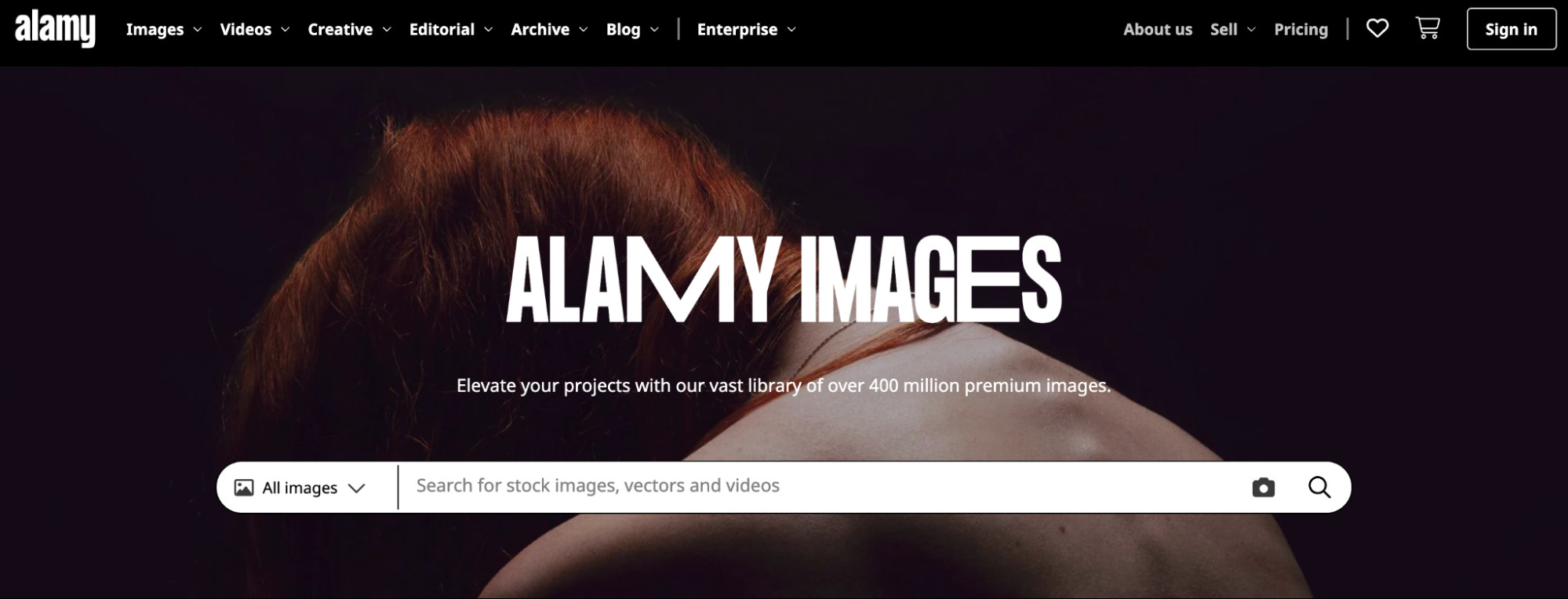 Alamy Images homepage showcasing a royalty-free image search bar.
Alamy Images homepage showcasing a royalty-free image search bar.
Alamy boasts one of the most diverse stock photo collections on the internet, making it an excellent platform to sell your own photos. Alamy offers millions of stock images, vectors, videos, and 360-degree panoramic images, providing numerous opportunities for you to contribute. Alamy also offers an iOS app called Stockimo, which allows you to sell photos online directly from your phone. With diverse content options and mobile accessibility, it opens doors for photographers to showcase and sell their work to a broad audience.
How To Get Paid
Alamy provides monthly payments to its contributors with several commission models. Photographers can earn between 17% and 50% of sales, depending on the image popularity and license type. There are no long-term contracts with Alamy, and you can get paid in multiple currencies. Alamy is a great platform for photographers looking for flexibility and diverse earning opportunities.
1.2. 500px
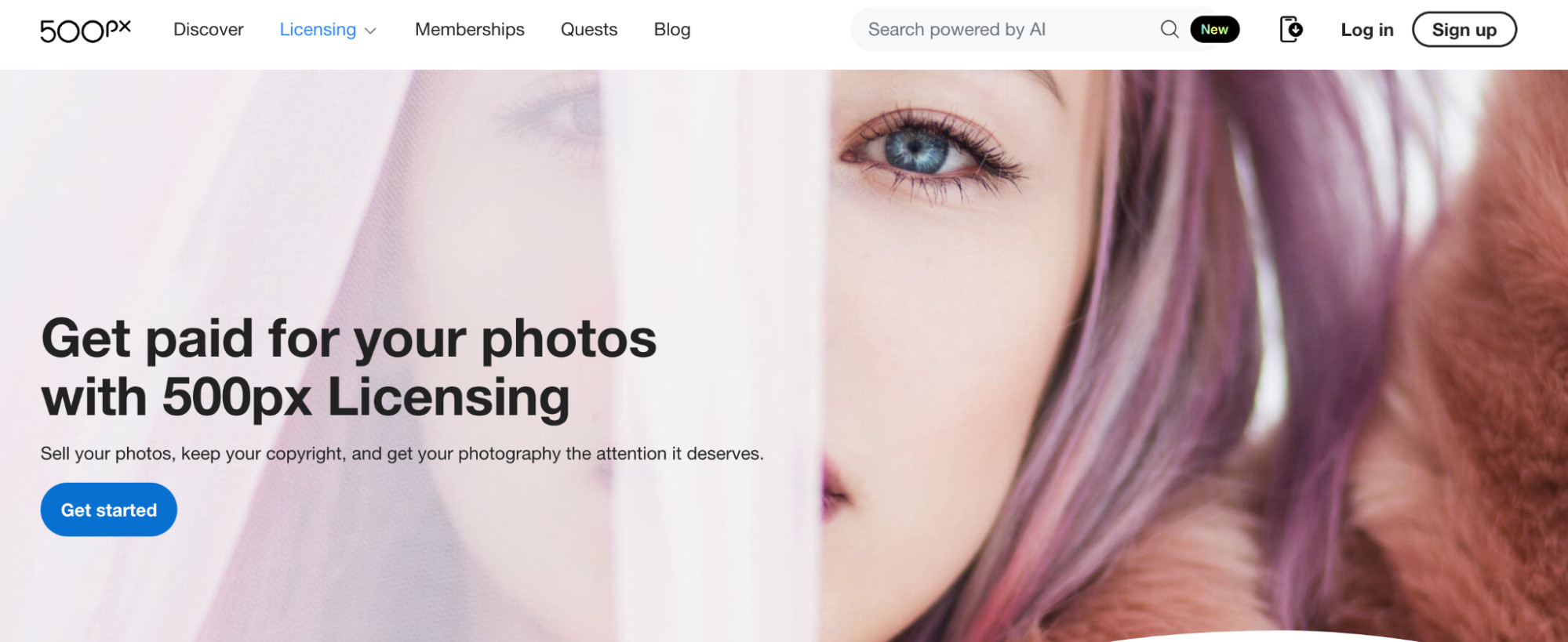 500px homepage demonstrating paid photo licensing for contributors.
500px homepage demonstrating paid photo licensing for contributors.
500px combines stock photo licensing with community features. 500px hosts millions of photographers who sell and license photos online. The Pulse algorithm surfaces new photographs and photographers to clients, so inexperienced photographers can gain recognition, provided their photos meet the platform’s quality standards.
In addition to being a platform for selling, 500px is also an online community for amateur and professional photographers. You can follow other photographers, get feedback on your work, list photos in the online marketplace, and participate in photography competitions for prizes. It’s a holistic platform that supports growth and visibility for photographers of all levels.
How To Get Paid
Paying members can earn up to 100% royalties for exclusive photos. According to research, 500px members have a strong opportunity to maximize their earnings by offering exclusive content.
1.3. Shutterstock
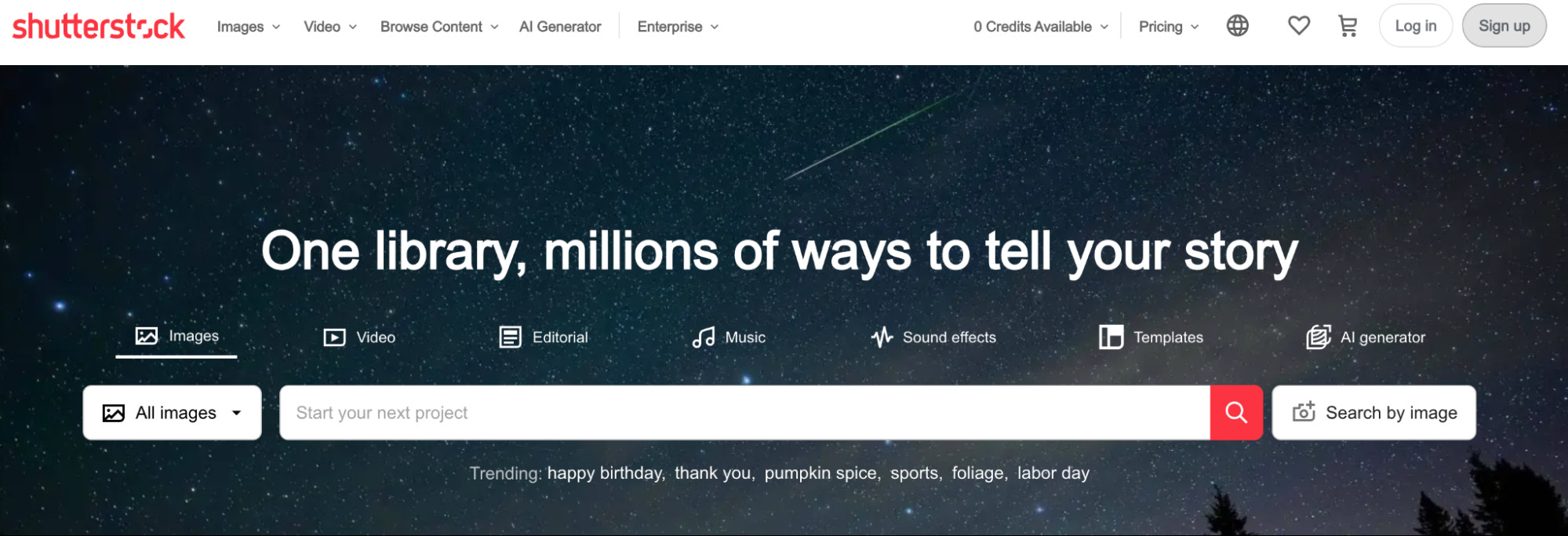 Shutterstock homepage offering royalty-free images, videos, and music.
Shutterstock homepage offering royalty-free images, videos, and music.
Shutterstock is one of the most popular photography websites for selling photos online. Shutterstock has paid out more than $1 billion to its community in the past 15 years. With such a significant payout history, Shutterstock is a reliable option for photographers looking to monetize their work.
Shutterstock is considered a micro-stock site, where photos are cheaper and non-exclusive. The main way to increase downloads is by contributing a large quantity of images. While you may not expect to earn as much with Shutterstock, it’s a good place to start if you’re learning how to sell stock photos. It provides a low-barrier entry point for beginners to gain experience in the stock photography market.
How To Get Paid
Payouts are based on earnings over time and range from 15% to 40%. There’s also an affiliate program where you can earn additional money if you refer new photographers or customers. Shutterstock offers multiple ways to increase your income through both direct sales and referrals.
1.4. Getty Images
 Getty Images homepage facilitating photo and image searches.
Getty Images homepage facilitating photo and image searches.
Getty Images attracts brands and online publishers looking for high-quality or hard-to-find exclusive images to license. The platform, along with its microstock site, iStock (below), reaches more than 1.5 million customers around the world. Getty Images’ broad reach offers photographers access to a vast and diverse customer base.
To maintain its reputation among publishers, the standards for selling your photography with Getty are stricter than many other stock photo sites. Meeting these high standards can lead to greater visibility and higher earning potential.
How To Get Paid
Apply to become a contributor with a set of sample photos. After you’re accepted, you’ll be paid anywhere between 15% and 45% of an image’s license fee. Acceptance into Getty Images can provide a significant boost to a photographer’s career.
1.5. iStock
 iStock landing page showcasing its AI-powered image creator.
iStock landing page showcasing its AI-powered image creator.
iStock is an offshoot of Getty Images. The major difference between the two stock photo platforms is that photos on iStock can be non-exclusive, which means you can sell your photography with other agencies. This flexibility makes iStock a great option for photographers wanting to diversify their selling platforms.
How To Get Paid
To sell your photos with iStock, you need to apply with a set of sample images. Commissions range from 15% to 45%, depending on contributor agreements. iStock provides a clear and structured commission system for its contributors.
1.6. Stocksy
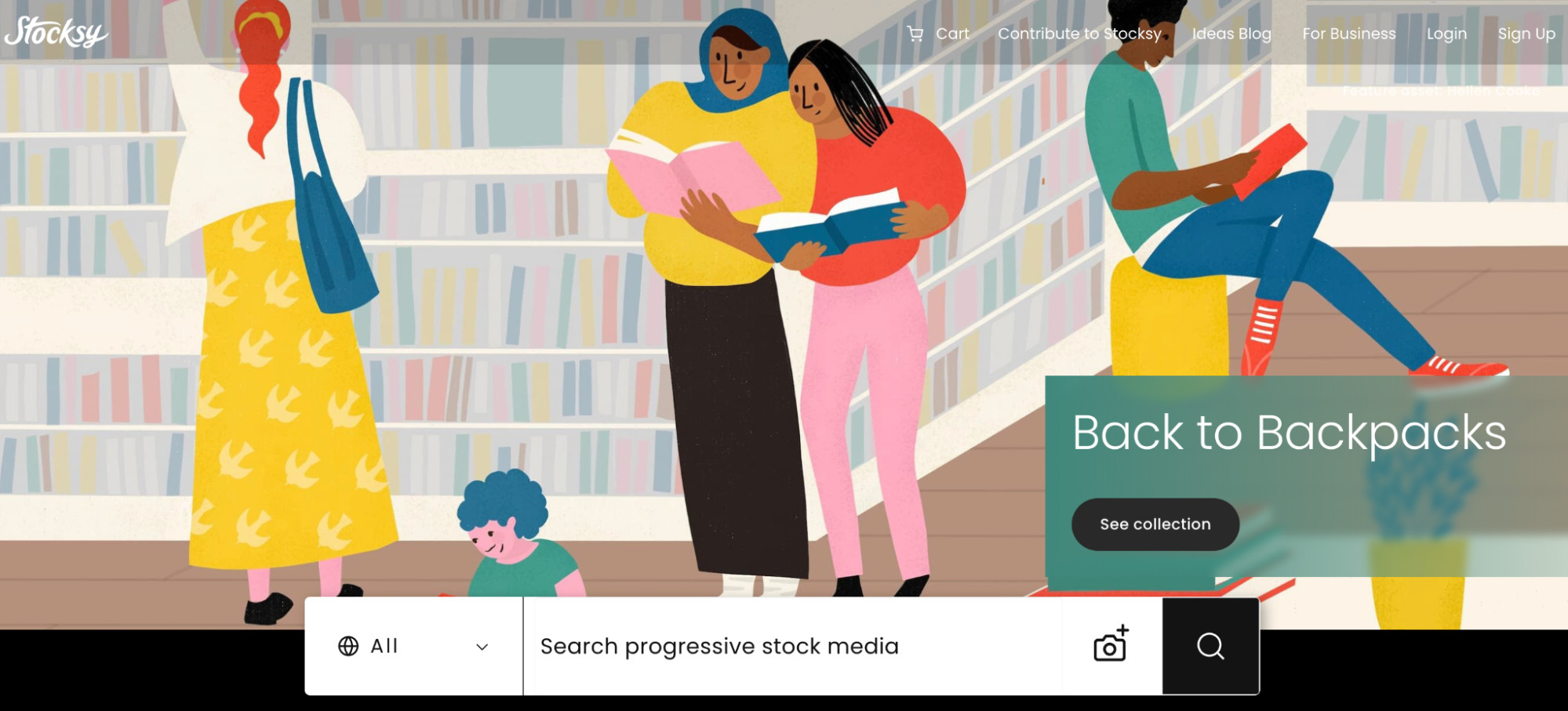 Stocksy homepage featuring people in a library graphic.
Stocksy homepage featuring people in a library graphic.
Stocksy is a popular stock photography site that offers high payouts to contributors. Photographers can earn a 50% royalty on standard licenses and a 75% royalty on extended licenses. But all photos must be exclusive to the platform. The high royalty rates make Stocksy an attractive option for exclusive photographers.
Stocksy is an artist-owned cooperative, which means contributors are part owners of the business and can help control its direction. Contributors can also receive profit-sharing in the form of patronage returns when the co-op has a surplus. This unique cooperative structure allows photographers to have a direct stake in the platform’s success.
How To Get Paid
Stocksy contributors are paid monthly via PayPal, Payoneer, or check, with a minimum payout of $100. If you’re interested in selling photos on Stocksy, check out its contributor application FAQ. The straightforward payment system and clear application process make it easy for photographers to get started.
1.7. Picfair
 Picfair landing page for photographers' website builder.
Picfair landing page for photographers' website builder.
Picfair is a good option if you want a degree of control over your online photo portfolio. You can set your own prices for photos—both prints and digital downloads—and Picfair handles payment processing. It also manages print production, shipping, and licenses for digital images. Picfair’s control over pricing and services makes it ideal for photographers who want to manage their brand.
How To Get Paid
Sign up for a Plus plan, priced at $4 per month when billed annually. Create a custom Picfair store with up to 10,000 images that can be sold as prints or downloads. The subscription-based model offers a cost-effective way to manage a large photo portfolio.
1.8. Adobe Stock
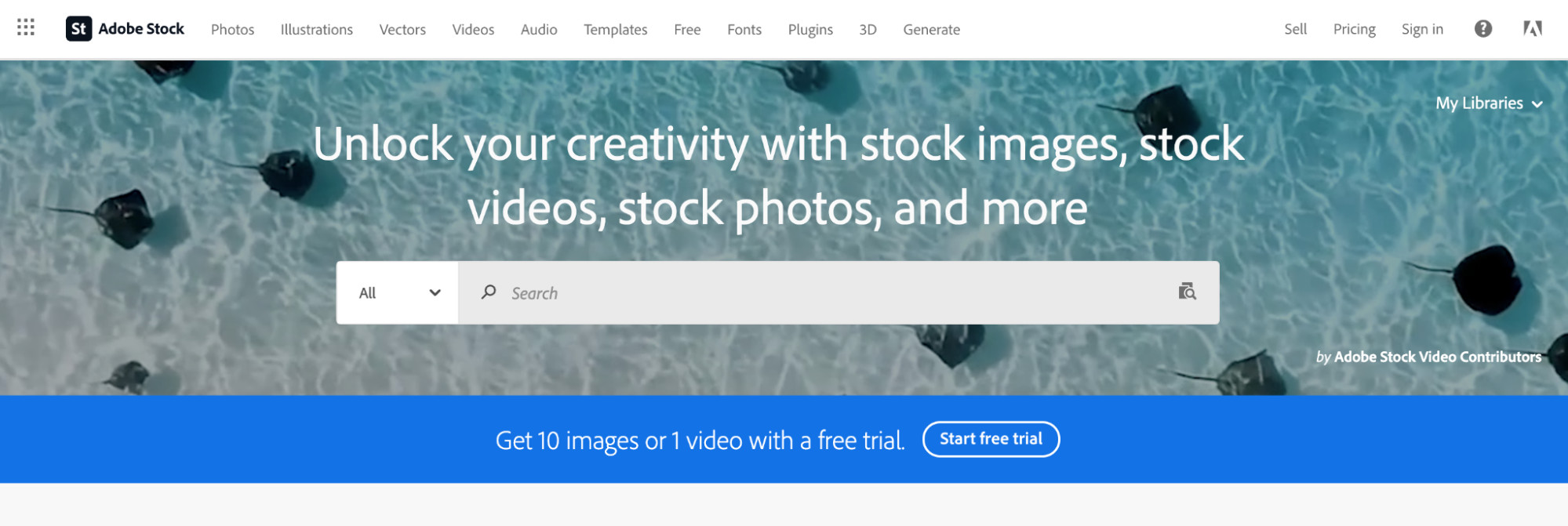 Adobe Stock homepage with an ocean stingrays photo and search bar.
Adobe Stock homepage with an ocean stingrays photo and search bar.
If you use the Adobe suite for photography projects, you can add your images, videos, vectors, and illustrations to Adobe Stock, the company’s online stock photo platform. The integration with Adobe’s creative suite makes it seamless for users to upload and manage their content.
How To Get Paid
Upload assets directly from Lightroom and Bridge when you’re finished editing. Contributors who link their Adobe ID to Adobe Stock can earn 33% royalties on photos and 35% on videos. The straightforward royalty system and direct upload capability make Adobe Stock a convenient option for Adobe users.
1.9. Envato Elements
 Envato Market landing page for stock photos.
Envato Market landing page for stock photos.
Envato Elements is a stock photography site where you can start selling your photos online and connect with potential clients. With Envato Elements, you can sell photos on its app or upload photos to your own site on the brand’s domain. Either way, it’s a popular place to sell pictures and make money online doing what you love. It offers flexible selling options, whether through its app or a personal site, to suit different photographer preferences.
How To Get Paid
Contributors earn between 25% and 50% of net subscription revenue. The revenue-sharing model provides a direct link between the platform’s success and the earnings of its contributors.
1.10. Unsplash+
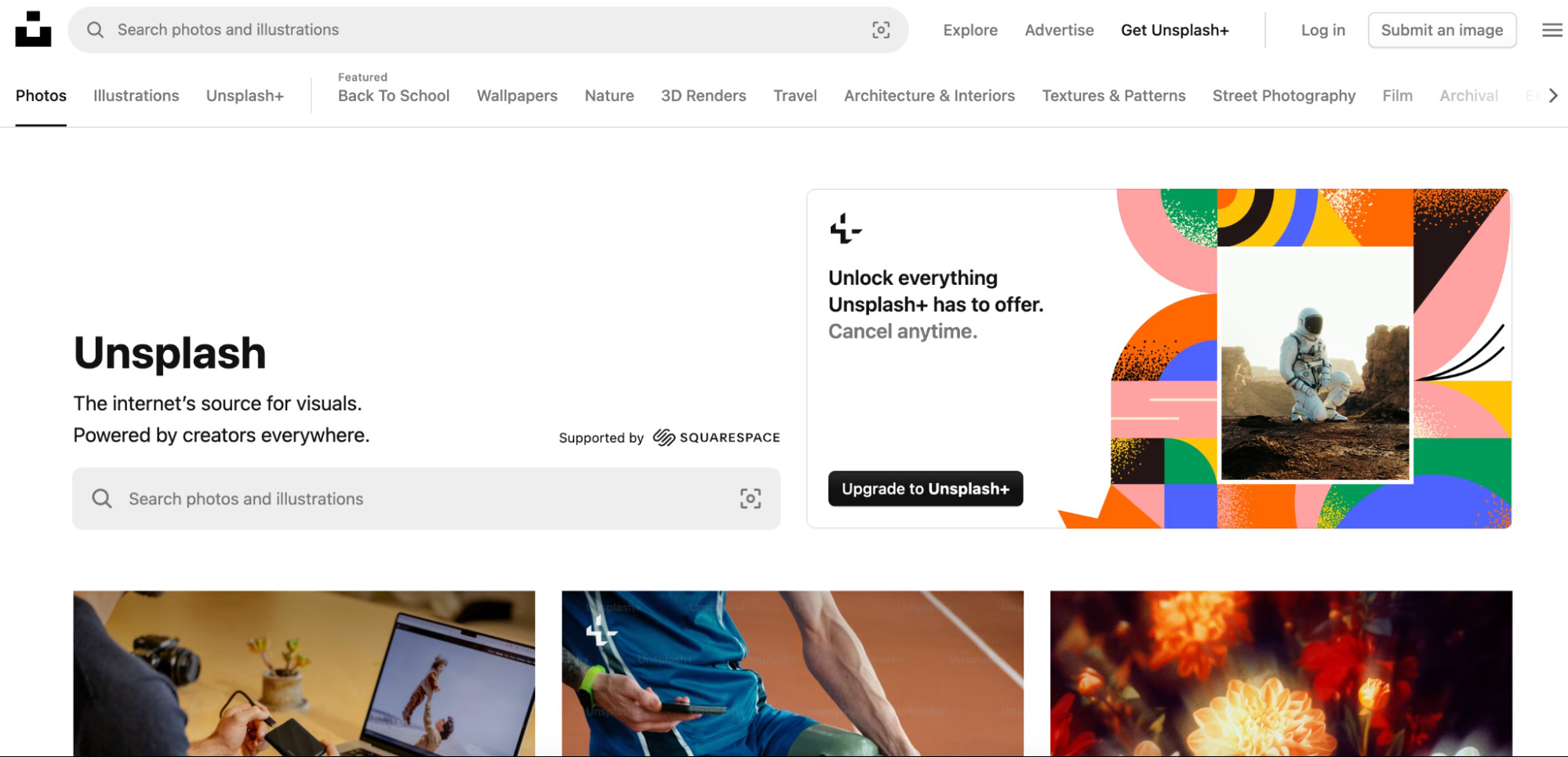 Unsplash homepage showing stock photos and a call-to-action.
Unsplash homepage showing stock photos and a call-to-action.
Unsplash is a free stock photo site that’s also owned by Getty. Instead of paying photographers based on sales of submitted photos, Unsplash partners with contributors through its Unsplash+ program, where photographers respond to briefs and requests. This unique approach provides photographers with specific assignments and guaranteed payment for accepted work.
How To Get Paid
Once you’ve completed the Unsplash+ contribution application and been accepted, you’ll see a list of briefs created by Unsplash customers. Choose a brief that suits your skills, upload your photos, and get paid for each accepted image. Rates for photos range, on average, between $5 and $30 per image. The brief-based system offers a structured and reliable way for photographers to earn income.
1.11. Dreamstime
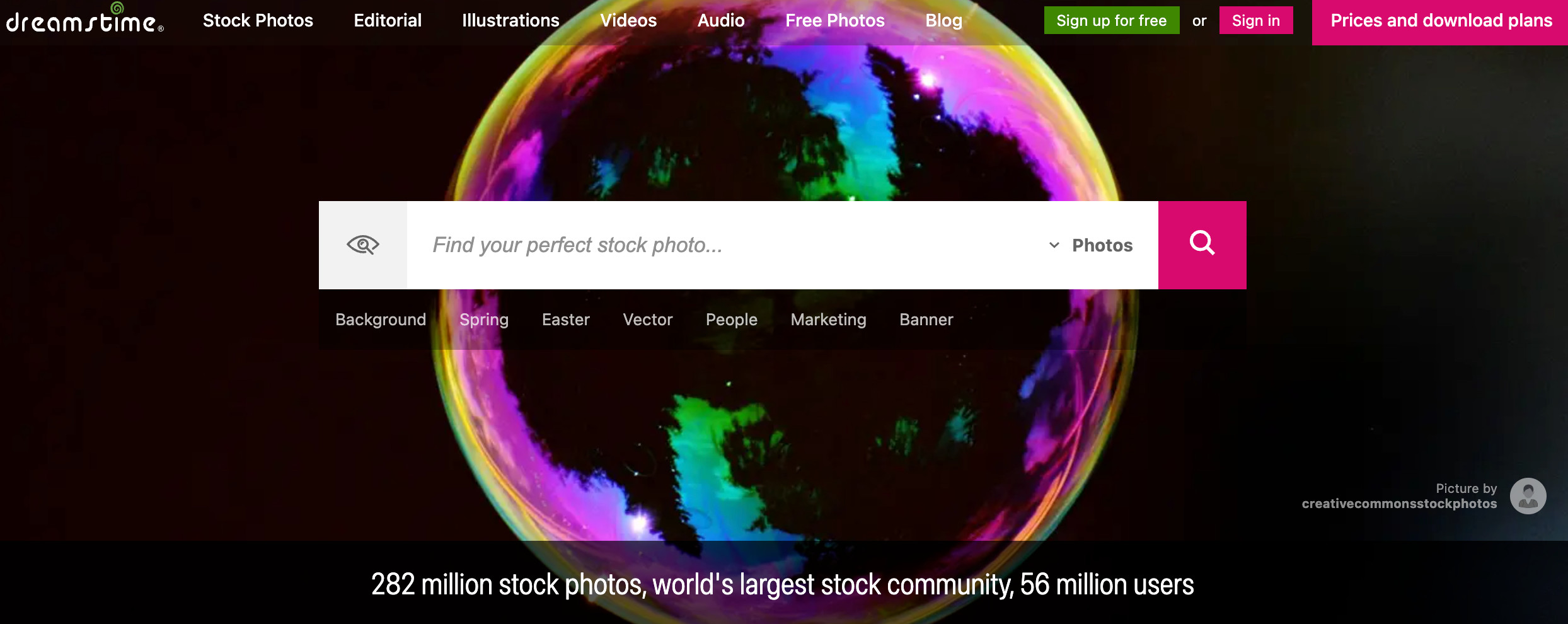 Dreamstime homepage for selling photos.
Dreamstime homepage for selling photos.
Dreamstime is a microstock platform with a huge range of royalty-free media, including stock photos, vectors, videos, and audio files. With a library of more than 250 million files and a user base of over 50 million, Dreamstime gives photographers access to a large, active audience. Its extensive library and user base provide significant exposure for contributors.
How To Get Paid
Dreamstime offers revenue sharing of 25% to 50% for non-exclusive content. Exclusive contributors earn an additional 10% and receive 20¢ for each approved submission. The platform also features an affiliate program that pays 10% of transaction values for each referred contributor or customer. With multiple earning avenues, Dreamstime offers a comprehensive monetization system.
1.12. Snapped4U
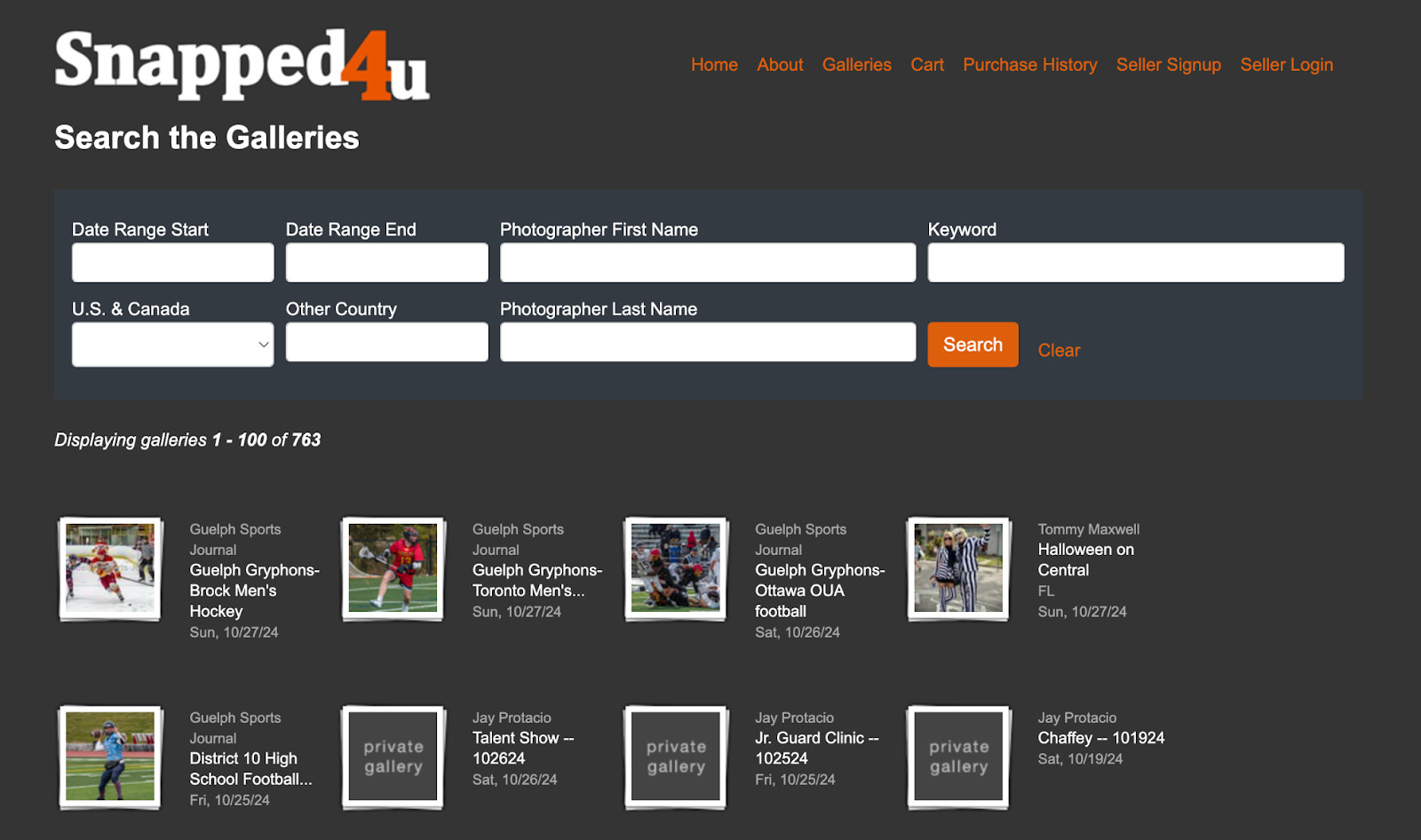 Snapped4U homepage featuring sports photographers' images.
Snapped4U homepage featuring sports photographers' images.
Snapped4U is a marketplace for photographers specializing in portrait and event photography. It lets photographers create personalized galleries, set their own prices (up to $20 per image), and sell digital files directly to clients. Its tailored approach makes it ideal for photographers focusing on specific niches.
In this way, Snapped4U is designed for photographers selling photos to customers who attended events or sat for portraits. Travel, landscape, and still-life photos are not accepted on the platform. This specialization ensures a targeted audience for event and portrait photographers.
How To Get Paid
Snapped4U charges a one-time $10 registration fee during sign-up and retains a 10% to 12% commission on sales. Photographers are paid the balance in their account via PayPal on the first and 15th of each month. The fee structure is transparent, and the payment schedule is consistent, providing reliability for contributors.
1.13. Foap
 Foap creator landing page promoting a mobile app for photographers.
Foap creator landing page promoting a mobile app for photographers.
Foap is a photo-selling site that allows photographers to sell commercial-quality images directly to brands and individuals. Photographers can participate in “missions,” where brands set specific photo or video requirements and reward winners. To date, Foap has paid out more than $3 million to creators. The mission-based approach offers photographers opportunities to earn higher payouts by meeting specific brand needs.
How To Get Paid
Mission payouts range from $100 to $2,000. Users can also sell individual photos on Foap market. Foap takes a 50% commission on all sales. The high potential payouts and direct brand connections make Foap an attractive platform for commercial photographers.
1.14. EyeEm
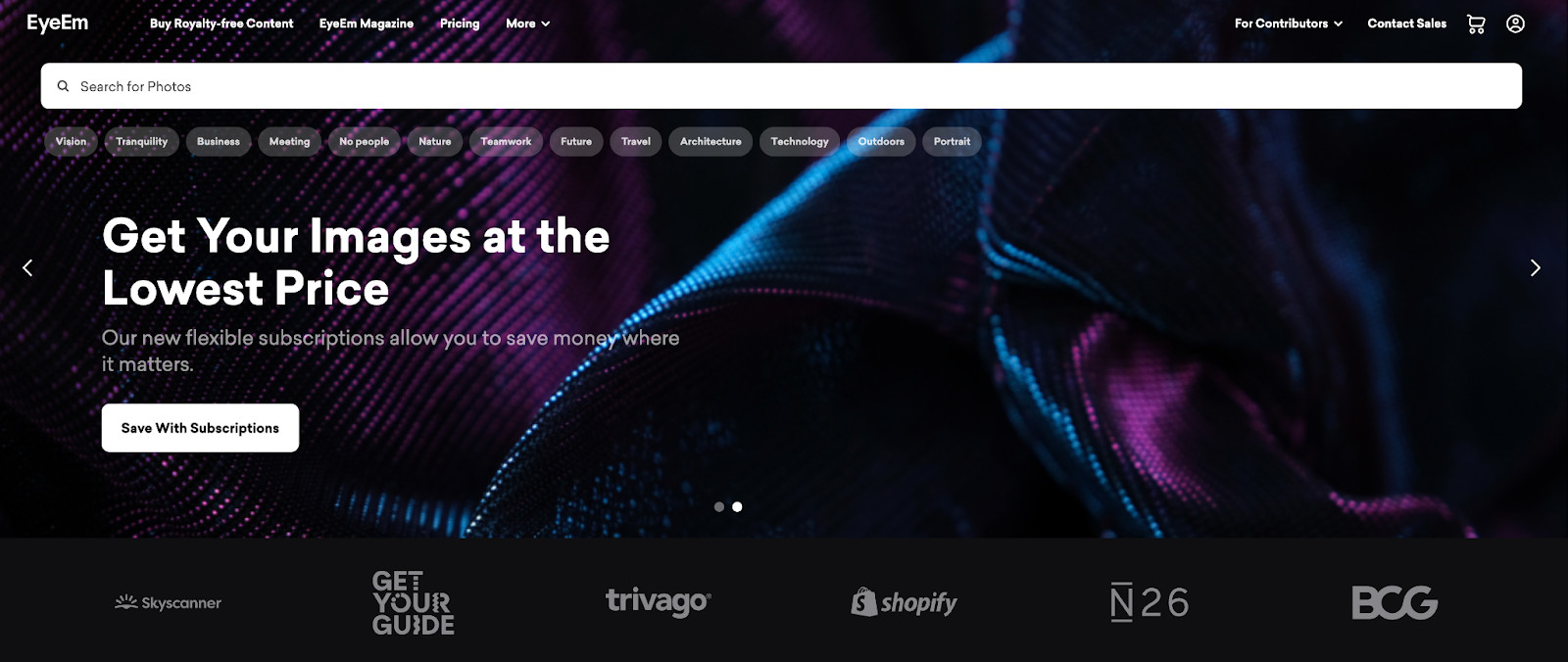 EyeEm homepage showcasing high-profile clients and a search bar.
EyeEm homepage showcasing high-profile clients and a search bar.
EyeEm combines a marketplace with a photographer community. The platform invites photographers to contribute to missions that call for images on a theme. This blend of community and commerce helps photographers connect and grow.
How To Get Paid
Contributors earn a 50% commission on each sale made through the EyeEm marketplace. Photographers are paid via PayPal. The combination of community engagement and a straightforward commission structure makes EyeEm a supportive and rewarding platform.
1.15. Pond5 (For Videos)
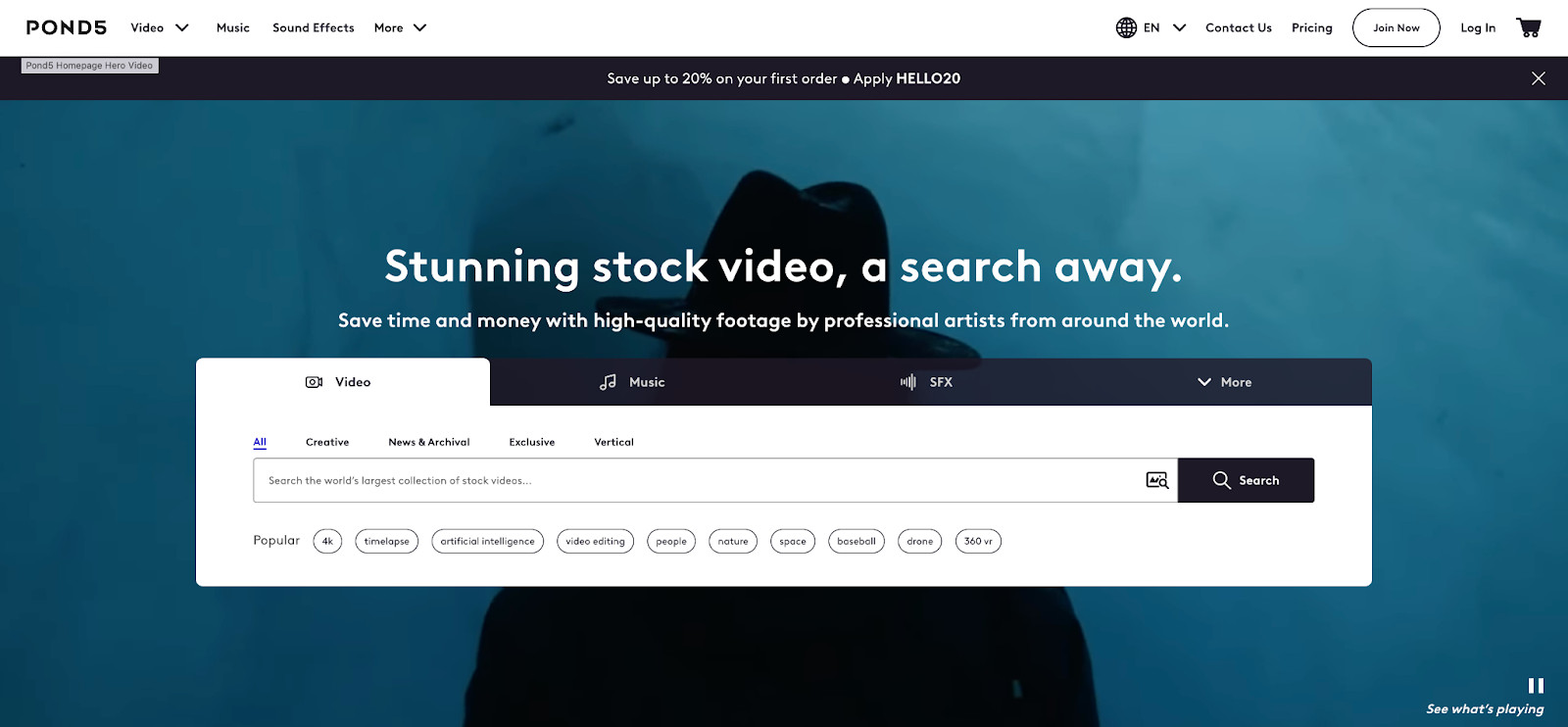 Pond5 homepage.
Pond5 homepage.
Pond5 is a marketplace for selling royalty-free videos, music, sound effects, and other assets. According to the platform, its one-million-strong customer base includes clients like the BBC and Disney, with contributor content used in ads, TV shows, and feature films. Contributors create Pond5 storefronts to showcase their media. Its focus on video content and high-profile clients sets it apart from photo-centric platforms.
How To Get Paid
Video artists earn a 40% royalty share, with the option to make your content exclusive and earn up to 60%. Contributors can respond to client briefs via the Artist Portal. Pond5 also offers a referral program where artists can earn additional income. With high royalty rates and diverse earning options, Pond5 is a strong choice for video creators.
2. Tips For Selling Photos Online
2.1. Define Your Stock Photography Niche
Many photographers have a consistent style or theme that runs through their work. Whether your focus is travel, fashion, nature, or food, consistency is key. Specializing in a niche helps you build a recognizable brand and attract a specific audience.
Photographers often feel their way into a niche by finding styles and subjects they enjoy shooting that also resonate with audiences. You can evaluate the demand for topics using keyword research to analyze search volume for terms related to your photographs. Google Trends is a basic tool you can use to see which image topics are gaining popularity. Analyzing market demand ensures your niche is viable and profitable.
2.2. Get On Instagram
Just like bloggers and YouTubers, photographers learning how to sell images online should also invest in building their audiences. Social media presence can significantly boost your visibility and sales.
Visual social platforms such as Instagram can help you reach a wide audience. Use Instagram tools to help you follow the right accounts, engage with popular hashtags, and grow a following of potential customers. Building a strong Instagram presence can drive traffic to your portfolio and increase sales.
Linking your social media accounts makes it easier to manage your photo-sharing across platforms and boost visibility. On Instagram, for example, you can link your accounts to also post your images to Facebook at the same time. Efficiently managing your social media efforts can save time and maximize impact.
2.3. Integrate E-Commerce Into Your Website
Most photographers have their own site to showcase their work to potential clients. By adding a Shopify Buy Button to your site, you can make it easier for customers to purchase stock images from you. Integrating e-commerce directly into your site streamlines the buying process.
Photographer Dave Sandford, for example, has a store that both showcases his wildlife photography and offers the opportunity to purchase prints and calendars. His integrated store provides a seamless buying experience for his audience.
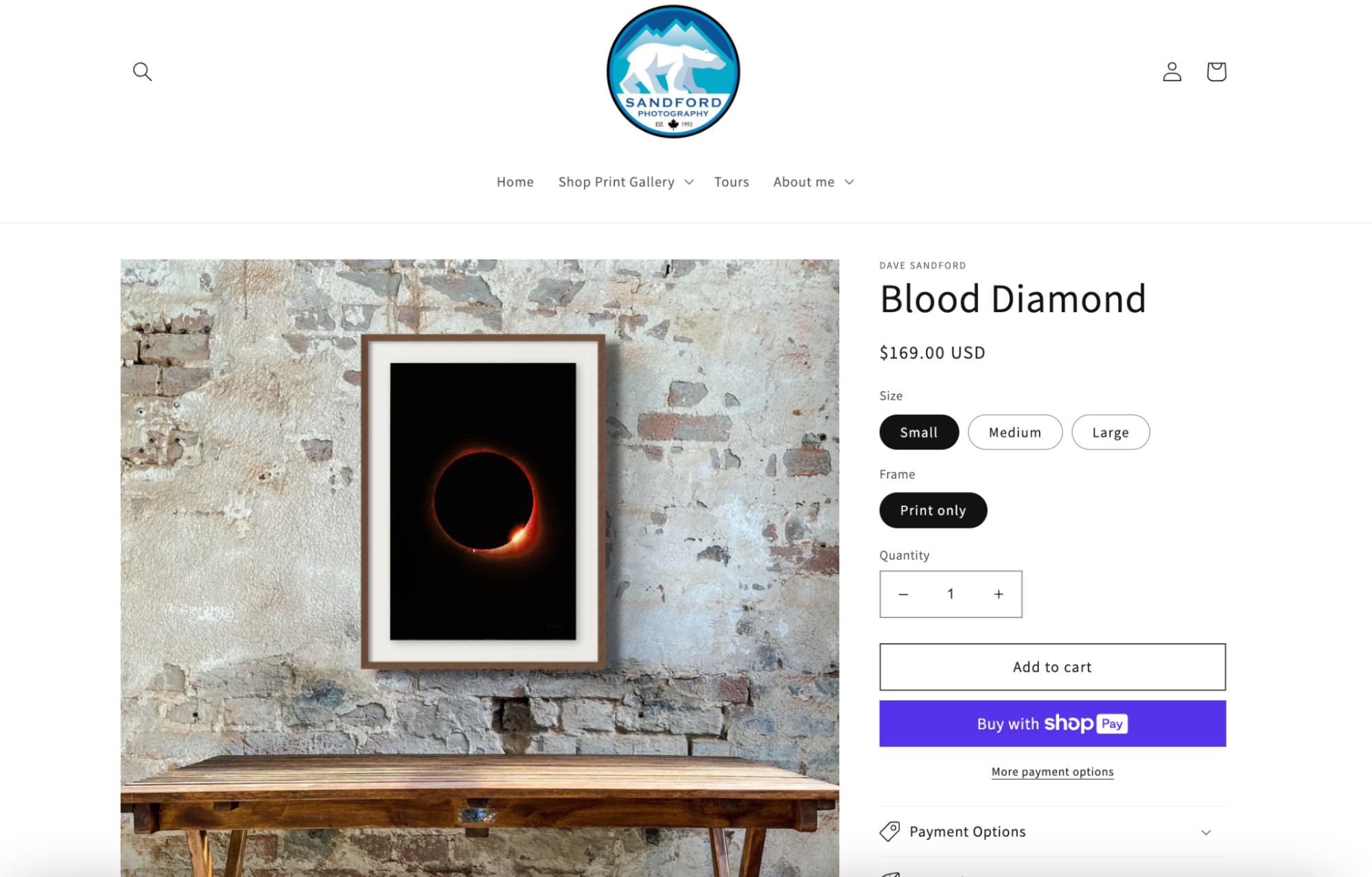 Product page from Dave Sandford Photos, featuring a moon print.
Product page from Dave Sandford Photos, featuring a moon print.
The easiest way to sell photos online is to build a personalized portfolio page or store on Shopify. A dedicated store allows you to control your brand and customer experience.
Use a pre-designed art and photography theme to set up your digital showroom, or combine a free theme with a gallery app. Customizable themes and gallery apps make it easy to create a professional and engaging online store.
2.4. Understand Your Market
Your target market is the group of people most likely to buy your photos. You can produce photos that appeal to them when you know who they are, what they’re interested in, and what they’ll buy. Understanding your audience helps you create relevant and marketable content.
Say you’re specializing in wedding photography, for example. People who buy stock images of weddings aren’t brides and grooms—they’re the suppliers who work within the wedding industry. Your target market might include wedding stationery brands or suit wholesalers who want to show royalty-free images of wedding celebrations in their marketing collateral. Identifying the actual buyers allows you to tailor your photos to their specific needs.
With this in mind, you can sell images that this buyer persona will buy, on the sites where they’re looking for stock images, at a price they’re willing to pay. Strategic placement and pricing ensure you maximize your sales potential.
3. How To Set Up Your Online Portfolio
3.1. Choose The Right Platform
There is no “best” platform to monetize your photos on; it depends on the goal of your photography business and how much control you’d like to have over your imagery. The ideal platform aligns with your business goals and desired level of control.
Here’s a quick rundown of your options. If you want to:
- Upload photos as a hobby or earn small amounts of passive income, try stock photo submissions on sites like iStock or Alamy
- Get assignments from brands without pitching them yourself, apply to be an Unsplash+ contributor
- Have complete control over your photography business, opt for an e-commerce platform like Shopify
3.2. Plan Your Portfolio’s Structure
A portfolio is a photographer’s résumé: a place for potential clients to view your past work and decide whether to hire you. A well-structured portfolio is crucial for attracting clients.
Pay attention to these elements of your portfolio:
- Layout. Photos should take center stage, but it helps to have some context on what the image is about. These mini product descriptions can influence purchase decisions and also improve your portfolio’s ability to rank in search engine results. Clear descriptions enhance both user experience and SEO.
- Social proof. Social proof is content that provides evidence of your work’s popularity. Gather quotes from previous happy customers or showcase how your images have been used in successful campaigns. Positive feedback and usage examples build trust.
- Categories and organization. Help potential customers browse images by keeping everything tagged and organized. If you’re a nature photographer, for example, try creating image collections by location, environment, subject, and date. Efficient organization improves navigability.
- Gallery size. Your online portfolio is what clients will consult when deciding whether to buy your photos. Ditch any photos you’re not satisfied with, and keep galleries limited to only high-quality images that showcase your best work. Quality over quantity ensures a strong impression.
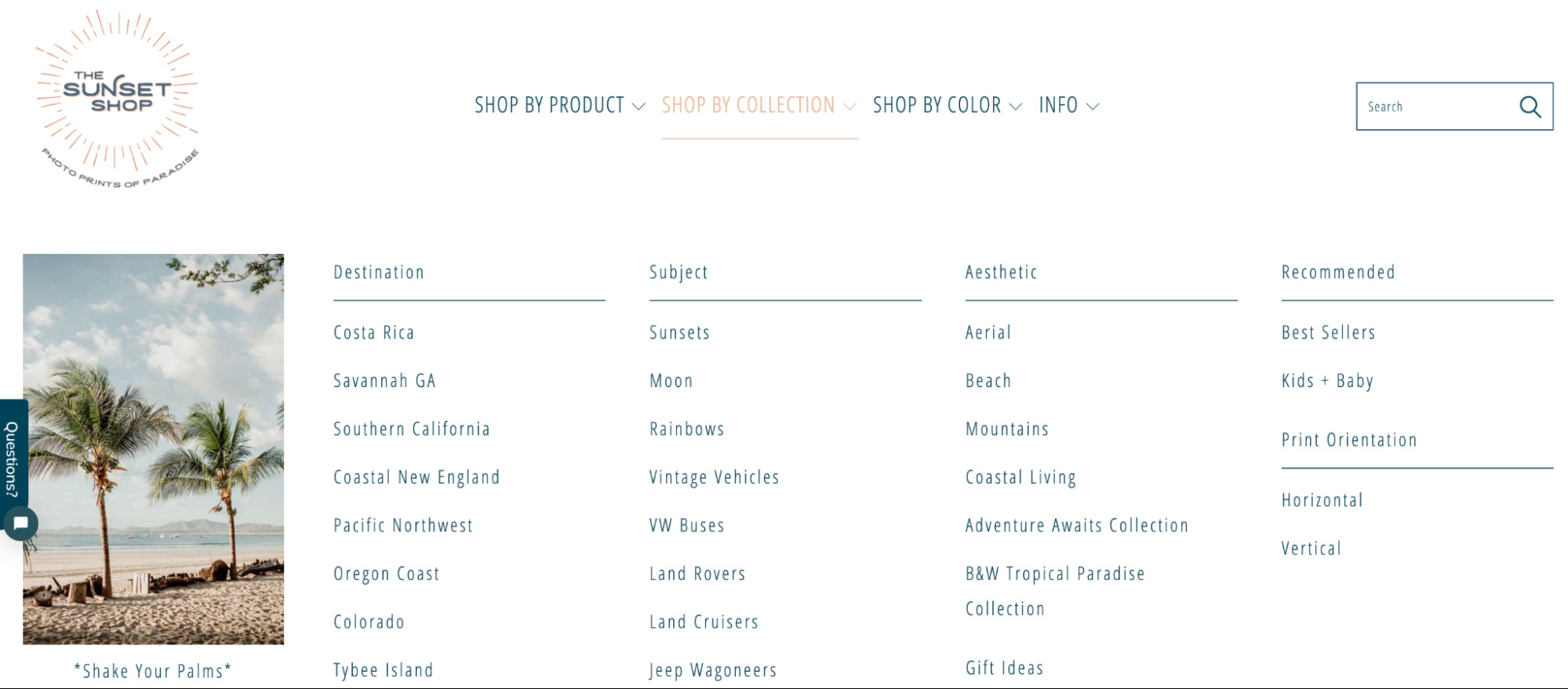 Example product categories on The Sunset Shop, including Costa Rica, Sunset, and Mountains.
Example product categories on The Sunset Shop, including Costa Rica, Sunset, and Mountains.
3.3. Optimize Images For The Web
Photographers often get frustrated when they’ve shot an incredibly detailed photo, only to have to compress it when they’re selling the image online. But fast-loading images are essential to the user experience. Large image files can make a webpage slower to load—and most people aren’t willing to wait around for slow site speeds. Website speed is critical for user retention.
When uploading images to your online photography portfolio:
- Compress image sizes. Images should be kept as small as possible without compromising quality. A general guideline is to compress images between 60% and 80%. Optimal compression balances quality and speed.
- Use descriptive file names. For example, name your file “summer-evening-nature” instead of “IMG_3542.jpg.” Clear filenames improve SEO.
- Write alt text. This tells search engines and people using screen readers what your photo is about. Alt text enhances accessibility and SEO.
3.4. Create An About Page
People buy from people, so it helps to have an About page that tells prospective customers about yourself. Include a brief summary on who you are and the story of your photography journey. A personal touch builds connections with potential clients.
This is an opportunity to sell yourself with a unique and engaging personal brand, so dive deep into your love of photography. How did you get into the industry? What types of things do you love to shoot? Where do you get your inspiration from? Sharing your story helps clients understand and appreciate your work.
3.5. Implement E-Commerce Functionality
An e-commerce platform handles the logistics of selling photos online. Creating your portfolio on Shopify, for example, will make it easy to: An e-commerce platform simplifies the selling process.
- Build an online storefront for people to self-serve and buy your products
- Set up shop on social media storefronts like Instagram Shop
- Take payment from customers and handle taxes
- Ship your products, either physically or digitally, to customers
- Manage marketing campaigns
 Product page for a 5×7 beach photo print from The Bee & The Fox.
Product page for a 5×7 beach photo print from The Bee & The Fox.
3.6. Ensure Mobile Compatibility
Not everyone who visits your online portfolio will be doing so on a desktop. Studies estimate that more than half of global website traffic happens through a mobile device, so check that your portfolio looks just as good on a smaller screen. Mobile optimization is crucial for reaching a wide audience.
Having a mobile website means using a responsive website design, displaying your photos vertically, and using large finger-friendly buttons. User-friendly design enhances the mobile experience.
3.7. Launch And Promote Your Photos
Now it’s time to share your photos with the world. Grab the link to your portfolio and share it online using marketing tactics like: Effective marketing is key to driving traffic and sales.
- Reposting images on social media
- Pinning photos on Pinterest and linking back to your portfolio site
- Gifting free prints to influencers
- Documenting the behind-the-scenes of a shoot on TikTok, YouTube, or Instagram Reels
- Building an email list by offering website visitors a discount code on their first order
4. How To Sell Photos As Prints And Photo Books
You can make and sell items that feature your photography for your customers to own, whether it’s as a simple framed print or a pillow. Selling your own physical products can be simpler than you think. Physical products offer a tangible way for customers to enjoy your art.
You can make money selling photos as prints on paper or physical products, such as mugs, t-shirts, and calendars. Popular sites and tools include:
The best way to sell photos online as physical prints or products is to work with a local photo lab that helps you ship and sell prints, or use a print-on-demand company to dropship a wide range of products (prints, phone cases, pillows, and more) featuring your photos. Print-on-demand services simplify production and shipping.
Be sure to order samples first to ensure the quality of the products match the quality of your photos. Quality control ensures customer satisfaction.
4.1. How To Sell Photography Online As Photo Books
Photo books are another physical product that can feature your photography. The more niche and consistent your photography is, the more likely you’ll be able to put together a stellar photo book based around a compelling theme and sell your art online. Photo books offer a curated and thematic way to showcase your work.
While you won’t get the best margins with print-on-demand services, it’s a risk-free way to test demand for your products before you decide to invest upfront. Testing demand minimizes financial risk.
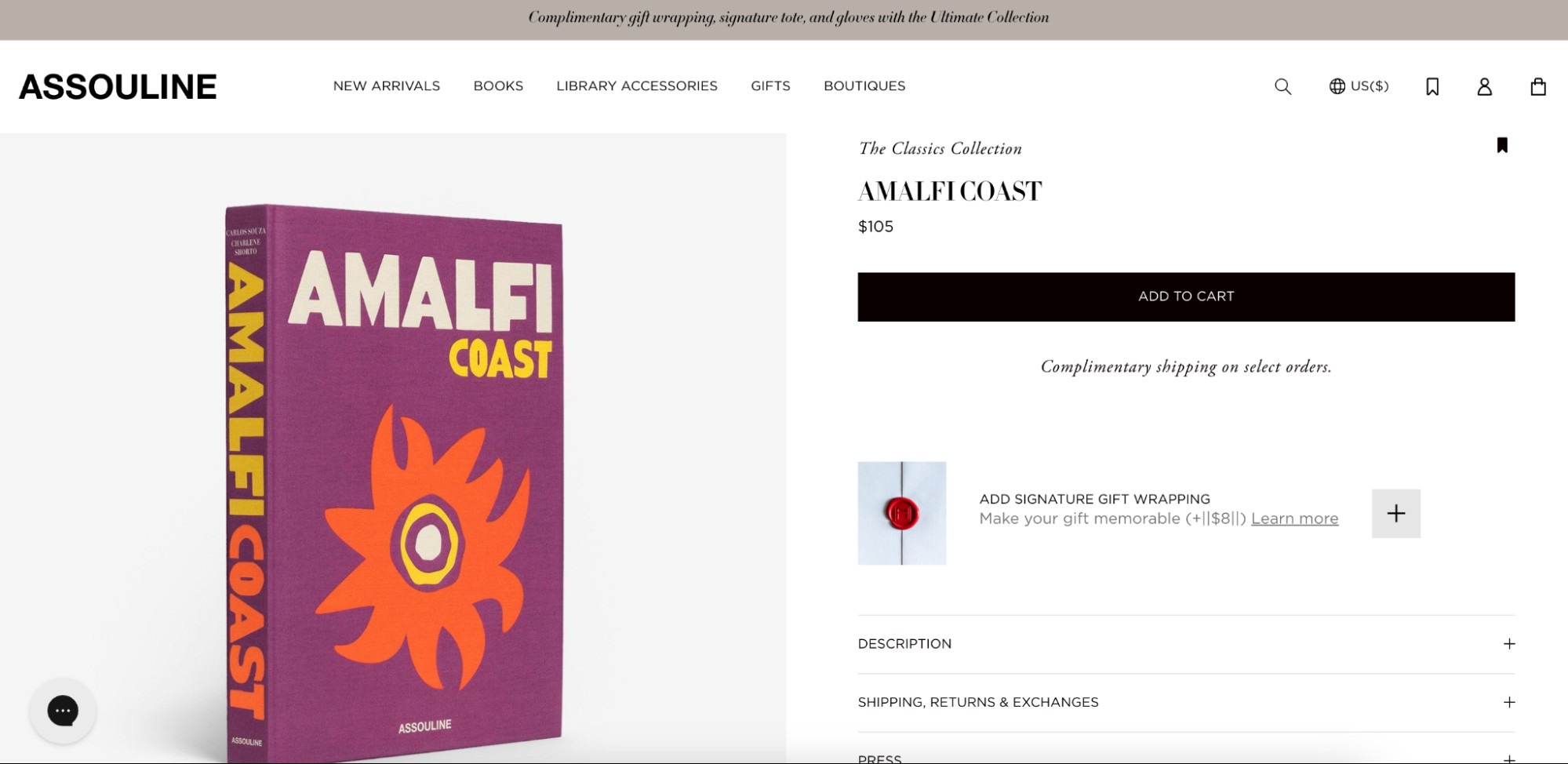 Photobook featuring images from the Amalfi Coast by Assouline.
Photobook featuring images from the Amalfi Coast by Assouline.
5. How To Sell Your Photography Services
Whether you’re covering events, doing fashion shoots, or getting into product photography, there are plenty of business opportunities available for professional photographers. Photography services offer diverse earning potential.
You can list your services in freelance directories like Fiverr and Upwork. But also consider networking locally, or meeting with clients via video chat. Online and offline networking can expand your client base.
Here are some networking tips for selling your photography as a service:
- Always have business cards handy. Use Shopify’s free business card generator to create your own.
- Tidy up your LinkedIn profile. Use it to showcase your work, and optimize it for the main photography service you provide (like event photography, for example).
- Attend networking events. Target ones where entrepreneurs and event organizers attend as these folks often need professional photographers.
- Build a personal brand. Regularly share your work on social media platforms so you’re top of mind when anyone in your network needs your skills.
Since photographers must operate in strict time slots, it’s good to have a booking platform you can use to let prospective clients see your schedule and book you when you’re available. Efficient scheduling is crucial for service-based photographers.
Both Setmore and SimplyBook.me have free plans and features that work well for photographers. If you’re using Shopify, you can add a scheduling app to book appointments directly from your site. Integrated scheduling streamlines the booking process.
6. Pricing Strategy For Selling Photos Online
Your talent and your determination ultimately decide your earning potential when selling photos online, but the income you get from doing what you love is some of the best cash you’ll ever earn. A strategic pricing approach can maximize your earnings.
Here’s how to decide on a pricing strategy for your photography business:
- Do market research. Ask your target market how much they’d pay for your photos and see how much comparable photos sell for on stock image sites.
- Determine your profit margins. Consider the costs of photography, like any equipment, website hosting fees, and marketing budgets. Make sure any revenue you make from selling your photos contributes to these expenses.
- Set different prices for usage. An exclusive photo can sell for a lot more money than a non-exclusive one.
- Offer discounts. Whether it’s a first-time customer or a loyal fan that you’re rewarding, experiment with discounts and promotions that incentivize people to buy your photos.
- Consider product bundles. Instead of selling one photo, sell a collection of related images at a discounted price. For example, one image of a beach might be $2.99, but a bundle of five beach-themed images could retail for $9.99.
7. Legal Primer For Selling Your Photos Online
While rights and licenses related to selling photography may seem confusing, there are key terms and concepts you should know to help protect yourself. Understanding legal aspects is crucial for protecting your work.
This is by no means a comprehensive list or a substitute for actual legal advice, but it should offer you broad definitions that will help you navigate the world of usage rights:
7.1. Glossary Of Legal Terms For Selling Photos Online
- Editorial use: Permission to use in blogs, newspapers, magazines, and other publications.
- Commercial use: Permission to use in marketing and advertising to promote a product or service.
- Retail use: Permission to use in the creation of a physical product to be sold. This includes prints, posters, and products that feature the photo (pillows, mugs, etc.). This term is sometimes discussed in the same context as commercial use, but it should be considered separately.
- Exclusive use: The one who purchases the license from you is the only one who can use the photo.
- Non-exclusive use: Photo licenses that can be purchased and used by anyone and usually cost less than exclusive ones.
- Public domain: When photos have no restrictions or copyright claims and can be used for commercial, editorial, and personal purposes. Works created by US federal government agencies (such as NASA) generally fall into this category unless otherwise stated.
- Creative Commons: Conditional usage of your work is allowed, as long as it’s in compliance with the stated restrictions. Attribution to credit the creator is sometimes required. Visit Creative Commons to generate a badge for this license for free.
- Royalty free: Others can buy a license and use the photo for an unlimited duration and unlimited number of times. This is the most common type of license purchased and is on the cheaper end of the spectrum because these photos are usually non-exclusive.
- Rights managed: A one-time license can be purchased to use the photo with restrictions regarding distribution. Additional licenses must be purchased for additional use.
- Right of publicity: The subjects in your photos are entitled to certain rights when it comes to their inclusion in your photography, especially when it comes to commercial use when you sell photos online. This is a separate concern from the copyright considerations above, and you should seek a subject’s explicit permission first in order to be safe.
7.2. What To Do If Someone Steals Your Photos
Theft is common concerning content, and many people do it unknowingly. Protecting your work from theft is essential.
Photographers can watermark their digital images before selling them online to protect against theft. If you sell or share your photos, you can apply identifying marks in Photoshop or use a watermark generator. Watermarks deter unauthorized use.
A smaller watermark, often in the corner, will less impact your photo, while a larger watermark with reduced opacity offers the most protection against theft. Effective watermarks balance visibility and protection.
But what do you do if someone steals and uses your photos anyway? A cease and desist request usually will work. Or you can send the culprit an invoice for using your photo. Combining the two will likely be the most effective at persuading the perpetrator by offering them the choice to either pay you or take the photo down. Legal action can be effective in addressing theft.
At the very least, you should always try to get others to credit you whenever they use your work, even for editorial purposes. Remember that backlinks to your portfolio site are useful for driving traffic to your other work and for search engine optimization and helping your standing in Google search results. Proper attribution can boost visibility and SEO.
FAQ: How To Sell Photos Online
What Is The Best Way To Sell Photographs?
The best way to sell photographs online is by selling them as stock images for sale on third-party websites like iStock, Shutterstock, or Alamy. Selling your photos through stock sites is quick, easy, and affordable. These platforms offer a broad audience and simplified selling processes.
Where Can I Sell My Photos Online For Money?
- Alamy
- 500px
- Shutterstock
- Getty Images
- iStock
- Stocksy
- Picfair
- Adobe Stock
- Envato Elements
- Unsplash
These platforms provide diverse options for selling your photos online.
How Do You Make Money From Stock Photography?
A stock photography website, or stock agency, sells high-priced and exclusive images that you upload. The agency licenses individual images to the client and sells them for a set price. Then you, the photographer, get a royalty payment. This royalty-based system allows you to earn income from your uploaded images.
Ready to turn your passion for photography into a profitable online business? Visit gmonline.net for more tips, resources, and community support to help you succeed. Don’t wait – start selling your photos online today and unlock your earning potential!
Address: 10900 Wilshire Blvd, Los Angeles, CA 90024, United States
Phone: +1 (310) 235-2000
Website: gmonline.net
